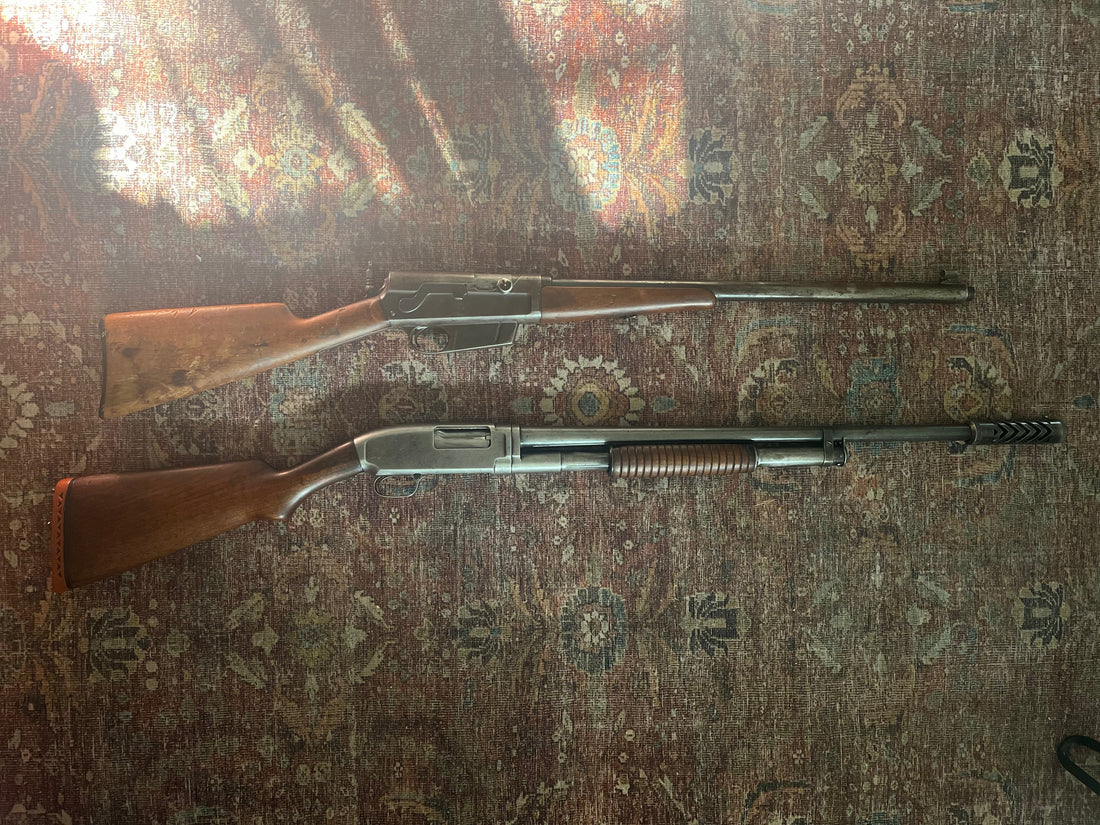There are many articles and blog posts written about the Model 12, discussing different models, their rarity, chamber sizes, and a plethora of other details.
This article is different. I assume if you're here, you already know the Winchester Model 12 is a great shotgun. Instead, I’ll focus on what to look for, where to find them, and common issues with these shotguns, many of which are over 100 years old and have been handled by countless owners.
How I Got My First Model 12
It started with my father-in-law showing me the firearms owned by his stepfather, one of which was a 1954 Winchester Model 12. I can’t recall the exact model, but after seeing it, cleaning it, and shooting it, I was hooked—I had to get one.
A few weeks and many hours browsing GunBroker later, after losing a few auctions, I found one: a 1924 Model 12 with a replaced barrel and a Power-Pac choke. I picked it up from my local gun shop and brought it home for a thorough cleaning. The receiver was caked with gunk, dirt, and carbon buildup from what looked like decades of neglect. The safety had been replaced at some point and only worked half the time. The action rod was badly worn, making it nearly impossible to cycle the action after firing without significant effort.
In total, the gun cost me $380 on GunBroker, plus a $60 transfer fee at the gun shop, $35 for a safety replacement, and $150 for an action rod replacement by a gunsmith. Grand total: $625—well below the price of a Model 12 at the same gun shop.
What to Know When Hunting for a Model 12
Here are some key points to keep in mind when searching for a Model 12:
- Fixed Chokes: These shotguns come with fixed chokes. If you buy a full-choke gun, you’re stuck with it. Want a modified choke? You’ll need to find a Model 12 with that specific choke.
- Collectible Value: Model 12s are prized for many reasons—some are Trench Guns, others are sentimental because a parent or grandparent owned one, and they’re timeless in design. As a result, well-maintained examples command higher prices online.
- Gun Shop Prices: Prices vary widely. The shop where I picked up mine had Model 12s priced from $850 to $1,500, depending on condition, gauge, and model. Another local shop specializing in vintage firearms lists them from $275 to $600, based on condition and model.
- Gauge and Rarity: 12-gauge models are the most common, with millions produced, so they’re typically less expensive. 16- and 20-gauge models are rarer and pricier, while 28-gauge models are the rarest and command the highest prices.
- For Parts Guns: If you’re comfortable with extensive cleaning, learning disassembly, and working with a good gunsmith, a “for parts” Model 12 can be a cost-effective option. They’re relatively affordable, even online, and despite being labeled as “complex,” these shotguns are straightforward to restore. Just pay close attention to the bore condition—some need only a deep cleaning, while others are in rough shape and require more work.
If you want a Model 12 that’s ready to shoot off the shelf, check local pawn shops. Many pawn shop customers are unaware of or indifferent to the shotgun’s value, so you can often find a steal on one of the best shotguns ever made.
Field-Grade Model 12s
Field-grade Model 12s are the most common and affordable, often available for under $500 in working condition. These typically have 2¾-inch chambers, perfect for hunting with high-quality bismuth shot shells. Avoid steel shot—it can damage the barrel, especially nickel steel barrels, as these shotguns were designed for lead shot when it was king.
What to Check When Buying a Model 12
Here are critical components to inspect before purchasing:
- Action: The action is arguably the most important part. If it’s finicky or not smooth, it may need a deep cleaning, or the action rod could be worn, causing issues with unlocking the bolt. If it’s severely jammed and requires significant force to cycle, both issues are likely at play.
- Safety: These shotguns can be over 100 years old, and heavy use can wear out the safety. To test it, ensure the shotgun is unloaded, cock it, engage the safety, and pull the trigger. If the hammer falls with the safety on, the safety needs replacing.
- Bore: While these shotguns are overbuilt compared to modern pump guns, the bore condition varies. Many just need a thorough cleaning, but some are in fair or poor condition, requiring a replacement barrel to restore shooting condition.
- Bluing: The bluing protects the shotgun from corrosion. Some Model 12s have worn bluing, exposing bare steel, while others are nearly pristine. If you prefer the raw steel look, apply a good woodsman’s wax to protect the metal, especially for hunting.
- Magazine Tube: The magazine tube is prone to dirt buildup and corrosion because the action rod and forearm are difficult to remove. The Model 12 is a takedown shotgun, meaning the barrel and magazine assembly can be separated from the receiver and stock for easy transport. My father-in-law’s Model 12 is a dream to disassemble and reassemble, but mine is finicky and a pain to put back together. Check the magazine tube’s spring, as it can corrode and may need replacing.
Hunting down these old shotguns are the fun I look forward to. The character and history behind each one is something special. Hit up some local pawnshops on your hunt. You don't need to spend a lot of money either. Just be patient and smart with what you look at and return one of the best shotguns made by John Browning to the field.

